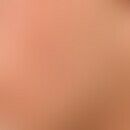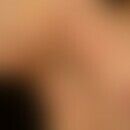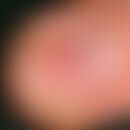HistoryThis section has been translated automatically.
Robert William Wood (American physicist), 1919
DefinitionThis section has been translated automatically.
Ultraviolet light (wavelength: 340 to 450 nm; maximum at 365 nm) coming from a UV lamp equipped with a special filter (wood filter). Due to the fluorescence, certain dermatomycoses are irradiated with Wood light in a dark room. This results in a fluorescent illumination. Ointments and creams can also fluoresce, therefore careful cleaning of the skin areas to be examined before the examination. Diagnostic indications for:
- Erythrasma (red fluorescence)
- Microspores (weak greenish fluorescence)
- Favus (toxic green fluorescence)
- Trichobacteriosis axillaris (orange fluorescence)
- Pityriasis versicolor (yellow-ochre fluorescence)
- Ash leaf spots (M. Pringle) (blue-white fluorescence compared to normal skin)
- Vitiligo (blue-white-light white fluorescence of depigmented areas)
- Skabies (grey-white mite ducts).
LiteratureThis section has been translated automatically.
- Asawanonda P (1999) Wood's light in dermatology. Int J Dermatol 38: 801-807
- Kefalidou S et al (1997) Wood's light in Microsporum canis positive patients. Mycoses 40: 461-463
- Wigger-Alberti W, Elsner P (1997) Fluorescence with Wood's light. Current applications in dermatological diagnosis, therapy follow-up and prevention. dermatologist 48: 523-527
- Wood R (1919) Communications secretes au moyen de rayons lumineux. J Phys Theor Appl 9: 77-90



